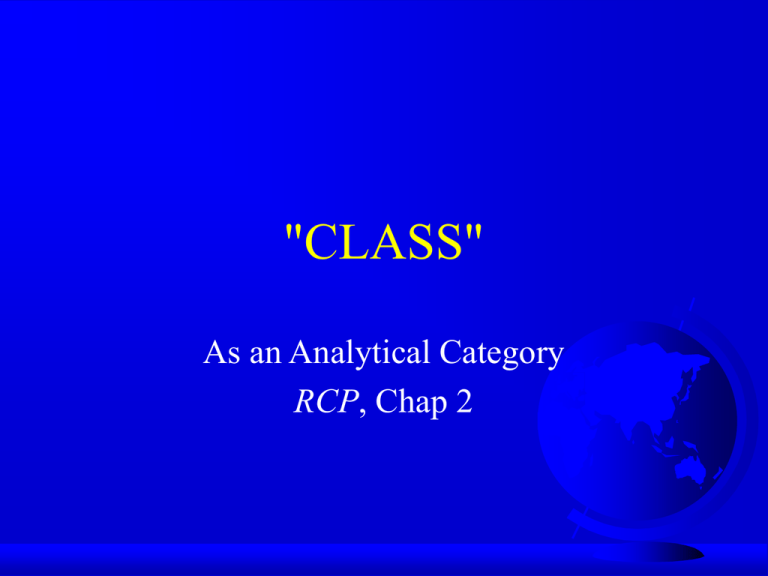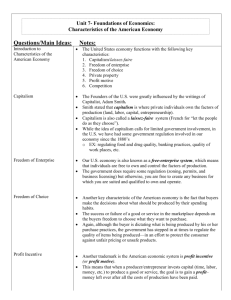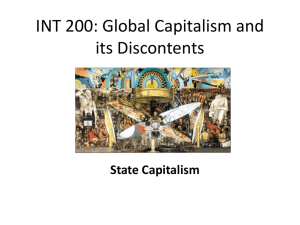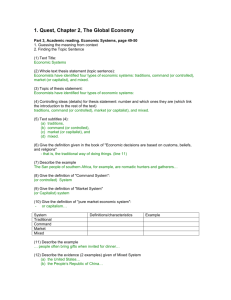The Concept of Class
advertisement

"CLASS" As an Analytical Category RCP, Chap 2 “Class” in 19th Century England Self-evident Especially “working class” Bipolarity in wealth, income, power Often used loosely, but commonly contradicted Classical Liberalism’s concept of atomistic society “Class” in Marx-1 Concept of “class” goes with capitalism capital = social relationship (not just money or machines) social relationship = centered on work “class” defined vis à vis work work is imposed by some on others, so ... “Class” in Marx-2 those who impose work = capitalist class those on whom work is imposed = working class imposition antagonistic relationship Objections to Category of “Class” Bipolarity of early capitalism changed by rise of “middle class” Dickensian dichotomy between rich & poor, owners & workers Mediated by middle layers, middle income Conclusion: capitalist - worker distinction is inadequate Should be replaced by “strata” etc. Marxist Responses empirical response: concentration of power empirical response: bipolarity continues on global scale theoretical response: “class” is not a sociological category Marx’s Concept of “Class” Elaborated two dimensions of concepts: class-in-itself class-for-itself Class-in-itself common characteristics like a sociological “classification” similar to philosophical concepts such as “being-in-itself” (Sartre) “being-in-itself” = “being which is what it is and is not what it is not” Working class in-itself those who work includes blue, white collar workers includes managers who organize includes engineers, scientists, etc., who invent, create 19th Century = factory workers + Today = almost everyone Capitalist Class in-itself those who impose work includes CEO’s, managers, overseers includes everyone who internalizes imposition of work 19th Century = owners, managers Today = almost everyone Class-for-itself Common struggle Category of self-activity Similar to philosophical concepts like “being-for-itself”(Sartre) “being-for-itself” = “being which is what it is not and is not what it is” “being-for-itself” = human being (for Marx, Sartre and many others) Working class-for-itself-1 working class defined by resistance to, and struggle against, imposed work everyone works, but not everyone struggles against it some just “do their job”; some struggle this self-activity can take many forms - forms have evolved over time, e.g., from “combinations” to “craft unions” to “industrial unions”to “rank & file insurgency” Working class-for-itself-2 “working class” also defined by struggle FOR alternative ways of being FOR “what we will”= multiplicity FOR time & energy to be citizens FOR time & energy for education FOR post-capitalist worlds Working class-for-itself-3 Struggles FOR alternatives ways-of-being which succeed that “working class” is an inadequate category Gauchos were only partly “workers” Gauchos were hardly “capitalists” Gauchos were “gauchos” --something “other”, outside the class relationship Capitalist class-for-itself-1 Capitalists EXPAND THE IMPOSITION of the rules of the capitalist game e.g., centrality of work e.g., markets, money, profit capitalists DEFEND against attacks capitalists CO-OPT alternatives Individuals & Class-1 “class” has been defined in terms of activity and behavior only individuals “behave” in this way or that way BUT clearly individuals are often in the situation of both having work imposed on them AND imposing work on others (including themselves) Individuals & Class-2 Implication: “class” concerns the ROLES individuals play vis à vis the current social system Class roles for individuals are often contradictory No “pure” capitalists or workers (Madame Defarge was wrong) Individuals & Class-3 Internal contradiction can mean: - schizophrenic lives - volatile, contradictory behaviors - fanaticism as solution e.g., professional revolutionary e.g., workaholic endless balancing act “Class” Composition Both classes are heterogeneous So, composition of classes must be analysed Composition is dynamic, changes with the class struggle 1) Political Recomposition, e.g., formation of combinations 2) Decomposition, e.g., Combination Acts “Class” and Revolution-1 “working class” is agent of revolution “gravediggers” of capitalism Revolution “explodes” capitalism Revolution replaces capitalism BUT does NOT replace one system by another Rather a system is replaced by diversity “Class” and Revolution-2 what might characteristics be? working class struggle AGAINST work means in post-capitalist society people will only work to live, working class will be abolished working class struggle FOR multiple alternatives means post-capitalist society will be multiple: societies 20th Century Socialism claimed to build one-class society of workers, workers’ state reproduced capitalist glorification of work reproduced class antagonisms of capitalism amounted to “state capitalism” rife with class struggle which brought it down 21st Century Revolution? Are Zapatistas the embodiment of Marx’s vision of an explosive revolution that destroys domination and liberates diversity? --END--





